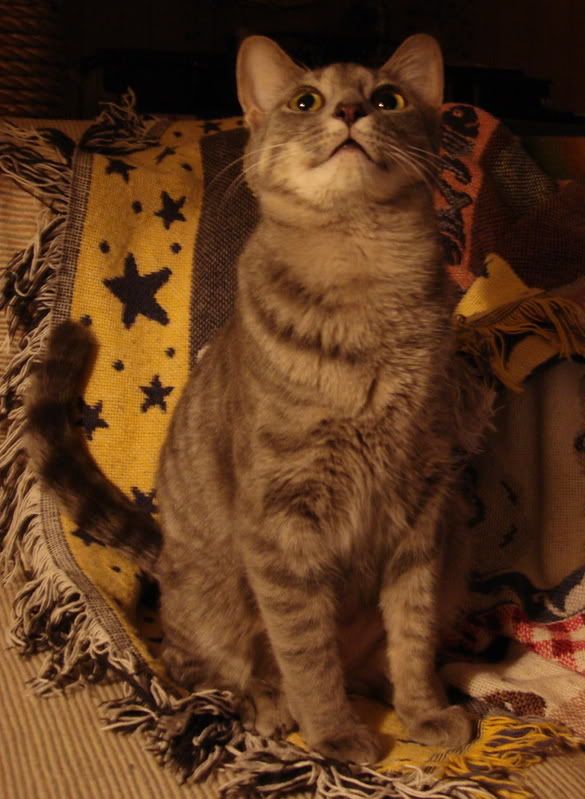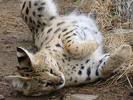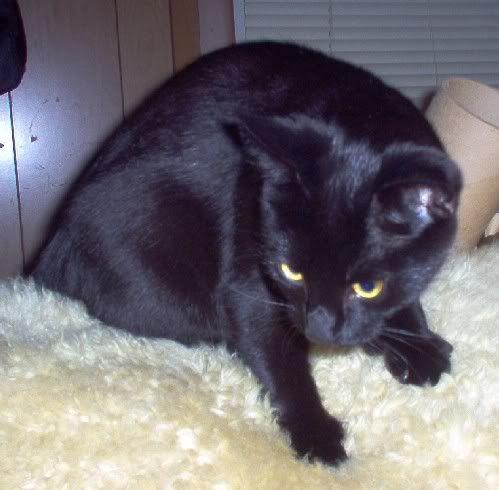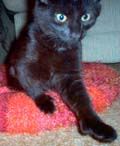

P-spectrum Utility Re-vibratory Response

We now examine in detail a very interesting aspect of the Feline Unit: the P-spectrum Utility Re-vibratory Response (PURR).
You may have noticed that your Feline Unit seems to have the uncanny ability to land on its feet and generally sustains very few injuries. This has recently been attributed, in part, to the healing properties of the PURR. What I will here call the “P-spectrum” comprises reverberating pulses generated in the throat region of the Feline Unit at a frequency of, optimally, 20-140 hertz (Hz).

P-spectrum vibrations at these frequencies have been found uniquely therapeutic for healing, pain relief, muscle growth and repair, and joint mobility.
We have all surely noticed our Feline Units employing the PURR during pleasurable activities, but the PURR is also activated under stress, while giving birth to new units [although it is strongly suggested that this option be deactivated, since their reproductive capabilities are quite astounding], and during pain and healing.


Following are excerpts from a few studies of the PURR which owners and aficionados of Feline Units may find interesting if they desire additional information on the subject.
~~~~~~~~~~~~~~~~~~~~~~~~~~
“Scientists have demonstrated that cats produce the purr through intermittent signaling of the laryngeal and diaphragmatic muscles. Cats purr during both inhalation and exhalation with a consistent pattern and frequency between 25 and 150 Hertz. Various investigators have shown that sound frequencies in this range can improve bone density and promote healing.”
Scientific American (January 27, 2003)

~~~~~~~~~~~~~~~~~~~~~~~~~~

“Cats do not have near the prevalence of orthopedic disease or ligament and muscle traumas as dogs have, and non-union of fractures in cats is rare. Researchers believe that self-healing is the survival mechanism behind the purr. There is extensive documentation that suggests that low frequencies, at low intensity, are therapeutic. These frequencies can aid bone growth, fracture healing, pain relief, tendon and muscle strength and repair, joint mobility, the reduction of swelling, and the relief of dyspnea, or breathlessness.
“Results indicated that despite size and different genetics, all of the individual cats [in the study, which included the cheetah, puma, serval, ocelot and the domestic cat] have strong purr frequencies that fall within the range of a multitude of therapeutic frequencies and particular decibel levels, see Fig. 3. Frequencies of 25 and 50 Hz are the best, and 100 Hz and 200 Hz the second best frequencies for promoting bone strength. Exposure to these signals elevates bone strength by approximately 30%, and increases the speed at which the fractures heal.”
Solving The Cat's Purr Mystery using Accelerometers, Elizabeth von Muggenthaler and Bill Wright, Brüel & Kjær, 2003

~~~~~~~~~~~~~~~~~~~~~~~~~~

[Don’t let the kooky look of this site put you off—this is the most comprehensive summary of the subject I found, and it’s excellent.]
“There is another clue found in a study performed by Dr. T. F. Cook, (1973) The relief of dyspnoea in cats by purring, New Zealand Veterinary Journal. A dying cat who could not breathe (they were considering euthanasia), was found to breath normally once it began purring. The purring opened up the cat's airway, and improvement was "remarkable and the next day commenced to eat...." Three species of cats have a strong harmonic at exactly 100 Hz, the vibrational frequency found to relieve dyspnea. One species within 2 Hz and one species within 7 Hz of 100 Hz. It could be that the cat's purr decreases the breathlessness by vibratory stimulation.
“Is it possible that evolution has provided the felines of this world with a natural healing mechanism for bones and other organs? Researchers at Fauna Communications believe so.
“Being able to produce frequencies that have been proven to improve healing time, strength and mobility could explain the purr's natural selection. In the wild when food is plentiful, the felids are relatively sedentary. They will spend a large portion of the day and night lounging in trees or on the ground. Consistent exercise is one of the greatest contributors to bone, (Karlsson et al, 2001), and muscle (Roth et al, 2000; Tracy et al 1999), and tendon and ligament strength (Simoson et al, 1995; Tipton et al 1975). If a cat’s exercise is sporadic it would be advantageous for them to stimulate bone growth while at rest. As well, following injury, immediate exercise can rebreak one and re-tear healing muscle and tendon (Montgomery, 1989). Inactivity decreases the strength of muscles (Tipton et al, 1975). Therefore, having an internal vibrational therapeutic system to stimulate healing would be advantageous, and would also reduce edema and provide a measure of pain relief during the healing process.”
The Felid Purr: A bio-mechanical healing mechanism, Fauna Communications Research Institute
~~~~~~~~~~~~~~~~~~~~~~~~~~

Free cat sounds, including purrs, for your listening pleasure.







16 comments:
I feel like after a lesson at university purr ! Your purr definition is just great. I will keep it not only in mind. It is true I also had to check if Lisa is still on the Microwave (her place for the day ?) when I saw Emma on your blog !
Wow, you humans sure have put a lot of study into the purr! I really enjoyed reading all of that. :) I learned a lot of new things! I just purr because it's what comes naturally to me. :)
I know how I purr, I don't need telling like humans do. My companion wants to know if the healing would apply to her!
Very educational, though. I approve.
Oscar.
Great post - cute pictures and very informative! Mouse says she has to get me to sit still more often so she can use her purring talents on me.
Very, very cool post! I learned a lot. And I guess when Chaos curls up against my tummy and purrs when I have cramps, he's really trying to help, isn't he?!
Oh, my! You and I have created havoc here! My "pride" - 3 Siamese - ran amock with the cat sounds. The alpha male has STILL not put all his tail fur down!
Know what? They don't like being laughed at, either! Thanks for making my day. Now DH is about to call his Mom and cheer her up with the cat's antics!
This is a fabulous entry, giving answers to mana questions. Old people used the have a cat laying on their backs or front when they had rheumatic pains. People thought it was the fur that did the healing. And another common healing method was of course "ultra-sound".
And here, in this very entry: The Anwers - also to the 9 lifes.
Thanks for the research. You merrit a Master for this one.
PS. Have forwarded your post to non-blogging collegues. They found it most interesting.
=^.^= =^.^= =^.^=
That was a very interesting article. Our cat, Otto, purrs all the time. Every time you pick him up he purrs. In fact, when I first found him he was a stray cat and strangers were petting him and he was purring. That just sold me on him and I had to bring him home. So happy I did!!!
I agree with TorAa who sent me here, it's an excellent post! Even me that's not a cat owner but a cat lover, enjoyed the reading.
Maybe it could exhange some other.... uhum... vibrating tools ;-)
Cats are extremely cool and interesting creatures. But we knew that.
Great post,very informative!
See you!!
Luna from Spain
=^.^=
Very nice to know all about the purr. Some kitties purr simply because you look at them.... and yet I have another who rarely purrs.
Oh, that was really cool to read about! And the pictures. Great post! And pictures.
Tyr and Thorne look pretty good in pictures too, although Tyr does seem a bit needy.
I was just thinking that cat's purring is probably similar to the healing soundwaves dolphins emit.
What a great post. I learned a lot and it was fascinating! I know how important purrs are for me when I feel low.
Have a great week and I'll see you next Tuesday!
To Oscar and my other feline readers ~ Thank you so much for visiting. You're SO fortunate that you can purr! I'm very envious.
Please tell your human companions that I'm not sure if the healing component applies to them, but I myself get as much of my feline companions' healing purrs as they will allow me to share.
One of the articles I read did say that chickens healed faster when placed on platforms that vibrated at the purr frequency, so one may infer that the good healing vibrations would likewise apply to humans.
I'm sure your human would be grateful for any purrs that you will grace her/him with.
Thank you for your seal of approval--it means a lot to me, as in my experience cats are a somewhat more discerning audience than humans.
Post a Comment